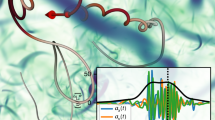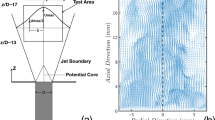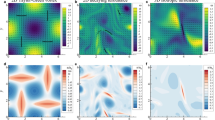Abstract
The motion of fluid particles as they are pushed along erratic trajectories by fluctuating pressure gradients is fundamental to transport and mixing in turbulence. It is essential in cloud formation and atmospheric transport1,2, processes in stirred chemical reactors and combustion systems3, and in the industrial production of nanoparticles4. The concept of particle trajectories has been used successfully to describe mixing and transport in turbulence3,5, but issues of fundamental importance remain unresolved. One such issue is the Heisenberg–Yaglom prediction of fluid particle accelerations6,7, based on the 1941 scaling theory of Kolmogorov8,9. Here we report acceleration measurements using a detector adapted from high-energy physics to track particles in a laboratory water flow at Reynolds numbers up to 63,000. We find that, within experimental errors, Kolmogorov scaling of the acceleration variance is attained at high Reynolds numbers. Our data indicate that the acceleration is an extremely intermittent variable—particles are observed with accelerations of up to 1,500 times the acceleration of gravity (equivalent to 40 times the root mean square acceleration). We find that the acceleration data reflect the anisotropy of the large-scale flow at all Reynolds numbers studied.
This is a preview of subscription content, access via your institution
Access options
Subscribe to this journal
Receive 51 print issues and online access
$199.00 per year
only $3.90 per issue
Buy this article
- Purchase on Springer Link
- Instant access to full article PDF
Prices may be subject to local taxes which are calculated during checkout




Similar content being viewed by others
References
Vaillancourt, P. A. & Yau, M. K. Review of particle-turbulence interactions and consequences for cloud physics. Bull. Am. Meteorol. Soc. 81, 285–298 (2000).
Weil, J. C., Sykes, R. I. & Venkatram, A. Evaluating air-quality models: Review and outlook. J. Appl. Meteorol. 31, 1121–1145 (1992).
Pope, S. B. Lagrangian PDF methods for turbulent flows. Annu. Rev. Fluid Mech. 26, 23–63 (1994).
Pratsinis, S. E. & Srinivas, V. Particle formation in gases, a review. Powder Technol. 88, 267–273 (1996).
Shraiman, B. I. & Siggia, E. D. Scalar turbulence. Nature 405, 639–646 (2000).
Heisenberg, W. Zur statistichen theorie der turbulenz. Z. Phys. 124, 628–657 (1948).
Yaglom, A. M. On the acceleration field in a turbulent flow. C.R. Acad. URSS 67, 795–798 (1949).
Kolmogorov, A. N. The local structure of turbulence in incompressible viscous fluid for very large Reynolds numbers. Dokl. Akad. Nauk SSSR 30, 301–305 (1941).
Kolmogorov, A. N. Dissipation of energy in the locally isotropic turbulence. Dok. Akad. Nauk SSSR 31, 538–540 (1941).
Virant, M. & Dracos, T. 3D PTV and its application on Lagrangian motion. Meas. Sci. Technol. 8, 1539–1552 (1997).
Ott, S. & Mann, J. An experimental investigation of relative diffusion of particle pairs in three-dimensional turbulent flow. J. Fluid Mech. 422, 207–223 (2000).
Skubic, P. et al. The CLEO III silicon tracker. Nucl. Instrum. Meth. A 418, 40–51 (1998).
Batchelor, G. K. Pressure fluctuations in isotropic turbulence. Proc. Camb. Phil. Soc. 47, 359–374 (1951).
Vedula, P. & Yeung, P. K. Similarly scaling of acceleration and pressure statistics in numerical simulations of isotropic turbulence. Phys. Fluids 11, 1208–1220 (1999).
Obukhov, A. M. & Yaglom, A. M. The microstructure of turbulent flow. Prikl. Mat. Mekh. 15, (1951); translation TM 1350 (National Advisory Committee for Aeronautics (NACA), Washington DC, 1953).
Gotoh, T. & Fukayama, D. Pressure spectrum in homogeneous turbulence. Phys. Rev. Lett. (submitted).
Gotoh, T. & Rogallo, R. S. Intermittency and scaling of pressure at small scales in forced isotropic turbulence. J. Fluid Mech. 396, 257–285 (1999).
Borgas, M. S. The multifractal Lagrangian nature of turbulence. Phil. Trans. R. Soc. Lond. A 342, 379–411 (1993).
Kurien, S. & Sreenivasan, K. R. Anisotropic scaling contributions to high-order structure functions in high-Reynolds-number turbulence. Phys. Rev. E 62, 2206–2212 (2000).
Shen, X. & Warhaft, Z. The anisotropy of the smale scale structure in high Reynolds number (Rλ ∼ 1000) turbulent shear flow. Phys. Fluids 12, 2976–2989 (2000).
Reynolds, A. M. A second-order Lagrangian stochastic model for particle trajectories in inhomogeneous turbulence. Q. J. R. Meteorol. Soc. 125, 1735–1746 (1999).
Sawford, B. L. & Yeung, P. K. Eulerian acceleration statistics as a discriminator between Lagrangian stochastic models in uniform shear flow. Phys. Fluids 12, 2033–2045 (2000).
Bidlingmayer, W. L., Day, J. F. & Evans, D. G. Effect of wind velocity on suction trap catches of some Florida mosquitos. J. Am. Mosquito Contr. 11, 295–301 (1995).
Voth, G. A., Satyanarayan, K. & Bodenschatz, E. Lagrangian acceleration measurements at large Reynolds numbers. Phys. Fluids 10, 2268–2280 (1998).
La Porta, A., Voth, G. A., Moisy, F. & Bodenschatz, E. Using cavitation to measure statistics of low-pressure events in large-Reynolds-number turbulence. Phys. Fluids 12, 1485–1496 (2000).
Sreenivasan, K. R. On the universality of the Kolmogorov constant. Phys. Fluids 7, 2778–2784 (1995).
Acknowledgements
This research is supported by the Physics Division of the National Science Foundation. We thank R. Hill, M. Nelkin, S. B. Pope, E. Siggia, and Z. Warhaft for stimulating discussions and suggestions throughout the project. We also thank C. Ward, who assisted in the initial development of the strip detector. E.B. and A.L.P. are grateful for support from the Institute of Theoretical Physics at the University of California, Santa Barbara.
Author information
Authors and Affiliations
Corresponding author
Rights and permissions
About this article
Cite this article
La Porta, A., Voth, G., Crawford, A. et al. Fluid particle accelerations in fully developed turbulence. Nature 409, 1017–1019 (2001). https://doi.org/10.1038/35059027
Received:
Accepted:
Issue Date:
DOI: https://doi.org/10.1038/35059027
This article is cited by
-
Divergence–curl correction for pressure field reconstruction from acceleration in turbulent flows
Experiments in Fluids (2023)
-
Tomographic long-distance µPIV to investigate the small scales of turbulence in a jet at high Reynolds number
Experiments in Fluids (2022)
-
Experimental Investigation of Droplet Generation by Post-Breaking Plunger Waves
Water Waves (2022)
-
An H2N2 Interpolation for Caputo Derivative with Order in (1, 2) and Its Application to Time-Fractional Wave Equations in More Than One Space Dimension
Journal of Scientific Computing (2020)
-
Higher-order statistics based multifractal predictability measures for anisotropic turbulence and the theoretical limits of aviation weather forecasting
Scientific Reports (2019)
Comments
By submitting a comment you agree to abide by our Terms and Community Guidelines. If you find something abusive or that does not comply with our terms or guidelines please flag it as inappropriate.



